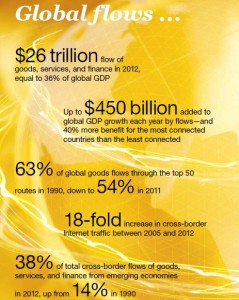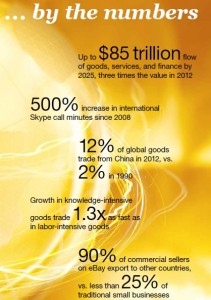Global flows have been a common thread in economic growth for centuries, since the days of the Silk Road, through the mercantilist and colonial periods and the Industrial Revolution. But today, the movement of goods, services, finance, and people has reached previously unimagined levels. Global flows are creating new degrees of connectedness among economies—and playing an ever-larger role in determining the fate of nations, companies, and individuals; to be unconnected is to fall behind.
Flows of goods, services, and finance reached $26 trillion in 2012, or 36 percent of global GDP, 1.5 times the level in 1990. Now, one in three goods crosses national borders, and more than one-third of financial investments are international transactions. In the next decade, global flows could triple, powered by rising prosperity and participation in the emerging world and by the spread of the Internet and digital technologies. Our scenarios show that global flows could reach $54 trillion to $85 trillion by 2025, more than double or triple their current scale.
A new McKinsey Global Institute (MGI) report, Global flows in a digital age: How trade, finance, people, and data connect the world economy, examines the inflows and outflows of goods, services, finance, and people, as well as the data and communication flows that underlie them all, for 195 countries around the world.
Our research finds that such flows matter for global GDP growth. Today, we estimate, they add between $250 billion and $450 billion to it every year, or 15 to 25 percent of the total. In addition, we find that countries with a larger number of connections in the global network of flows increase their GDP growth by up to 40 percent more than less connected countries do. The penalty for being left behind is rising.
MGI’s new Connectedness Index ranks 131 countries on total flows of goods, services, finance, people, and data and communication, adjusting for country size (exhibit). The index shows that developed economies remain more connected than emerging ones: Germany tops the list, followed by Hong Kong and the United States. Emerging economies are less connected to global flows, but some are climbing up the ranks rapidly: Morocco and Mauritius gained 26 places and 28 places, respectively, between 1995 and 2012—the largest increases in our index. Saudi Arabia rose 19 places, reflecting the rising value of oil exports and the recycling of oil wealth into global financial markets. India gained 16 places in this period, thanks to growth in services flows, and Brazil jumped 15 on the strength of expanding services and financial flows.
Within each type of flow, MGI finds that knowledge-intensive ones are growing faster than the labor-intensive or capital-intensive variety. Exchanges of goods such as aircraft and automobiles, semiconductors, pharmaceuticals, and microelectronics, as well as professional services and foreign direct investment flows, are growing faster than others. In 2012, knowledge-intensive flows reached $12.6 trillion, nearly half of total flows—more than the combined 2012 GDP of China and Germany. While the last era of globalization was driven largely by sourcing low-cost production, the next era will center on the rise of the global knowledge economy.
The spread of the Internet and of digital technologies is transforming all types of flows and creating new ones. Global online traffic across borders grew 18-fold between 2005 and 2012, and could increase eightfold more by 2025. Digital technologies, which reduce the cost of production and distribution, are transforming flows in three ways: through the creation of purely digital goods and services, “digital wrappers” that enhance the value of physical flows, and digital platforms that facilitate cross-border production and exchange. The enormous potential impact of digitization is only beginning to emerge. Consider that international Skype-call minutes grew to 40 percent of the present level of traditional international calls in just a decade. Or that cross-border e-commerce has grown to represent more than 10 percent of trade in goods in less than a decade.
James Manyika, Jacques Bughin, Susan Lund, Olivia Nottebohm, David Poulter, Sebastian Jauch, and Sree Ramaswamy
More: www.mckinsey.com


